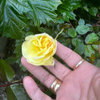New rose rosette research
henry_kuska
11 years ago
Related Stories

GARDENING GUIDESGreat Design Plant: Knock Out Roses
As glorious as their high-maintenance kin for a fraction of the work, Knock Out roses make even beginners look like garden stars
Full Story
GARDENING GUIDESWhat Kind of Roses Should You Grow?
Want to add the beauty of roses to your garden? Find out which ones, from old-fashioned to modern, are right for you
Full Story
GARDENING GUIDESLearn the Secret to Bigger and Better Roses
Grow beautiful roses using both ordinary and unusual soil amendments
Full Story
GARDENING GUIDES5 Sweet to Spirited Pink Roses for an Enchanting Garden
Whether you go demure or daring, there's a pink rose here to make you flush with garden pride
Full Story
GARDENING GUIDESRoses: Crowning Touch of Gardens
Whether you're the Miss or Mister America of gardening or take a hands-off approach, roses can be a winning addition to your landscape
Full Story
GARDENING GUIDES6 Wonderfully Easy Roses for Any Gardener
Look like an expert even if you're just starting out, with these low-maintenance gems of the rose world
Full Story
WINTER GARDENINGPruning Secrets for Exquisite Roses
Encourage gorgeous blooms year after year with this time-tested advice on how to prune your rosebush in winter for health and shape
Full Story
LIFEWhy We Want a House With a Great View
Research shows that just looking at nature has powerful mental benefits. Here's how to get a boost — with or without a million-dollar view
Full Story
HOUZZ TOURSHouzz Tour: An 1850s Ancestral Home in Texas Rises Again
See how exacting research and meticulous renovations gave a retired couple their dream home on a regained family plantation
Full StorySponsored
Leading Interior Designers in Columbus, Ohio & Ponte Vedra, Florida
More Discussions









kittymoonbeam
henry_kuskaOriginal Author
Related Professionals
Canton Landscape Architects & Landscape Designers · Birmingham Landscape Architects & Landscape Designers · Canton Landscape Contractors · Milford Landscape Contractors · Brownsville Landscape Contractors · Byram Landscape Contractors · Cockeysville Landscape Contractors · Cordele Landscape Contractors · Mission Landscape Contractors · Munster Landscape Contractors · North Richland Hills Landscape Contractors · Oak Harbor Landscape Contractors · Smyrna Landscape Contractors · Irvington Landscape Contractors · Northlake Landscape Contractorshenry_kuskaOriginal Author
henry_kuskaOriginal Author
mzstitch
michaelg
henry_kuskaOriginal Author
HannahB